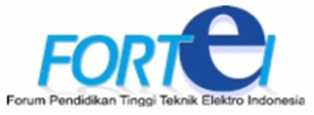Denoising Sinyal EEG dengan Algoritma Recursive Least Square dan Least Mean Square
Sari
Kata Kunci
Teks Lengkap:
PDFDilihat:
Referensi
S. Islam, A. M. El-hajj, H. Alawieh, Z. Dawy, N. Abbas, and J. El-imad, “Biomedical Signal Processing and Control EEG mobility artifact removal for ambulatory epileptic seizure prediction applications,” Biomed. Signal Process. Control, vol. 55, p. 101638, 2020.
N. Bajaj, J. Requena, F. Bellotti, R. Berta, and A. De Gloria, “Biomedical Signal Processing and Control Automatic and tunable algorithm for EEG artifact removal using wavelet decomposition with applications in predictive modeling during auditory tasks,” Biomed. Signal Process. Control, vol. 55, p. 101624, 2020.
C. J. Jeba and G. Suganthi, “Biomedical Signal Processing and Control An efficient denoising of impulse noise from MRI using adaptive switching modified decision based unsymmetric trimmed median filter,” Biomed. Signal Process. Control, vol. 55, p. 101657, 2020.
N. K. Muhsin, “Noise Removal of ECG Signal Using Recursive Least Square Algorithms,” Al-Khwarizmi Eng. J., vol. 7, no. 1, pp. 13–21, 2011.
X. Chen, X. Xu, A. Liu, M. J. McKeown, and Z. J. Wang, “The Use of Multivariate EMD and CCA for Denoising Muscle Artifacts from Few Channel EEG Recordings,” IEEE Trans. Intrumentation Meas., vol. 67, no. 2, pp. 359–370, 2018.
E. Estrada, H. Nazeran, G. Sierra, F. Ebrahimi, and S. K. Setarehdan, “Wavelet-based EEG Denoising for Automatic Sleep Stage Classification,” in 21st International Conference on Electrical Communications and Computers, 2011, pp. 295–298.
P. Gajbhiye, R. K. Tripathy, A. Bhattacharyya, and R. B. Pachori, “Novel Approaches for the Removal of Motion Artifact from EEG Recordings,” IEEE Sens. J., vol. 1748, pp. 1–10, 2019.
G. Kaushik, H. P. Sinha, and L. Dewan, “Biomedical Signals Analysis by DWT Signal Denoising With Neural Networks,” J. Theor. Appl. Inf. Technol., vol. 62, no. 1, pp. 184–198, 2014.
S. H. Sardouie, M. B. Shamsollahi, L. Albera, and I. Merlet, “Denoising of ictal EEG data using semi-blind source separation methods based on time-frequency priors,” IEEE J. Biomed. Heal. Informatics, vol. 2194, no. c, pp. 1–9, 2014.
K. Islam and A. Rastegarnia, “Probability Mapping Based Artifact Detection and Wavelet Denoising based Artifact Removal from Scalp EEG for BCI Applications,” in 2019 IEEE 4th International Conference on Computer and Communication Systems (ICCCS), 2019, pp. 243–247.
Harender and R. K. Sharma, “EEG Signal Denoising based on Wavelet Transform,” in International Conference on Electronics, Communication and Aerospace Technology ICECA 2017 EEG, 2017, pp. 758–761.
A. C. M. F. S. R. M. U. Ahmed, “A study of recursive least squares (RLS) adaptive filter algorithm in noise removal from ECG signals,” in 2015 International Conference on Informatics, Electronics & Vision (ICIEV), 2015, pp. 1–6.
V. Roy and S. Shukla, “Mth Order FIR Filtering for EEG denoising using Adaptive recursive Least Squares Squares Algorithm,” in 2015 International Conference on Computational Intelligence and Communication Networks, 2015, pp. 1–4.
J. Dhiman, S. Ahmad, and K. Gulia, “Comparison between Adaptive filter Algorithms ( LMS , NLMS and RLS ),” in International Journal of Science, Engineering and Technology Research (IJSETR), 2013, vol. 2, no. 5, pp. 1100–1103.
S.Arunkumar, P.Parthiban, and S. A. Kumar, “Implementation of Least Mean Square Algorithm For Sinusoidal and Audio Denoising Using FPGA,” Int. J. Adv. Res. Electr. Electron. Instrum. Eng., vol. 2, no. 12, pp. 5843–5850, 2013.
F. Ali, P. Rawat, and S. Malvia, “Comparative Analysis and Survey of LMS and RLS Adaptive Algorithms,” Int. J. Comput. Appl., vol. 161, no. 3, pp. 26–29, 2017.
DOI: https://doi.org/10.15575/telka.v5n2.122-129
Refbacks
- Saat ini tidak ada refbacks.
Jurnal TELKA terindex oleh :







Didukung oleh :


Ciptaan disebarluaskan di bawah Lisensi Creative Commons Atribusi-NonKomersial-BerbagiSerupa 4.0 Internasional.



